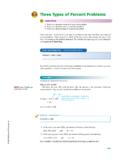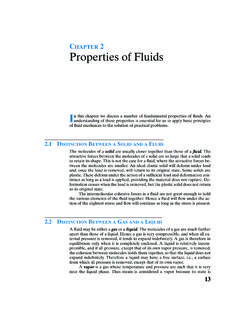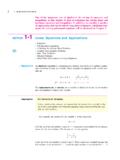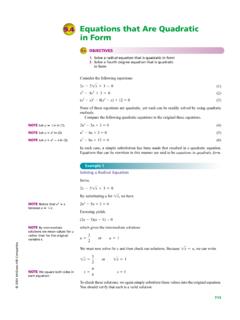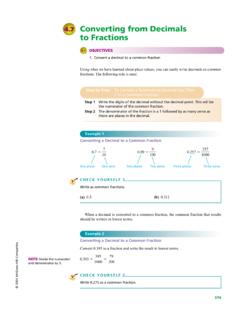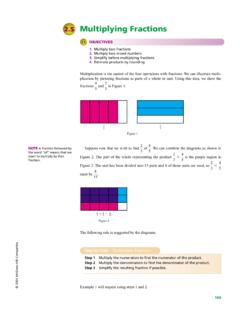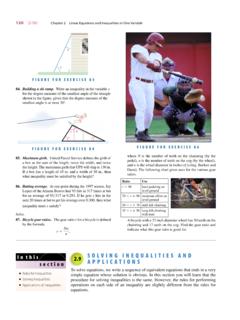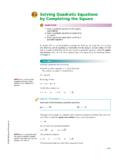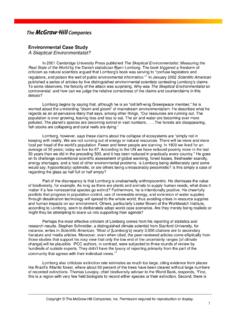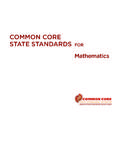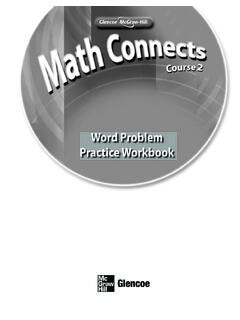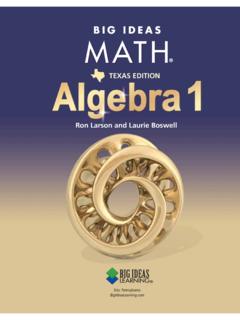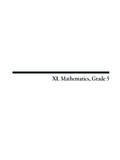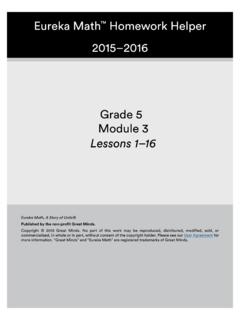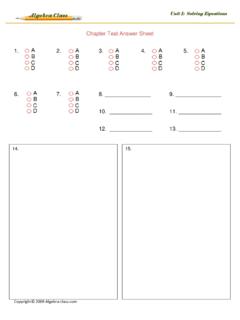Transcription of 5.4 Solving Proportions - McGraw Hill Education
1 2001 McGraw -Hill CompaniesSolving a proportion for an unknown valueA proportion consists of four values. If three of the four values of a proportion are known,you can always find the missing or unknown the proportion , the first value is unknown. We have chosen to represent theunknown value with the letter a. Using the proportion rule, we can proceed as a 3 10or15 a 30 The equals sign tells us that 15 aand 30 are just different names for the same type of statement is called an 1015a3 1015437An equationis a statement that two expressions are :EquationOne important property of an equation is that we can divide both sides by the samenonzero number. Here let s divide by a 301211a 2 You should always check your result.
2 It is easy in this case. We found a value of 2 for the unknown awith that value. Then verify that the fractions are proportional. We started with and found a value of 2 for a. So we write3 10 2 1530 30 The value of 2 for ais procedure for Solving a proportion is summarized as 1015a3 101515 a15 301515 a15 3015 Divide by the coefficient of the variable. Do yousee why we divided by 15? It leaves our unknownaby itself in the left is a proportion in which the first value isunknown. Our work in thissection will be learning how tofind that unknown will always divide bythe number multiplying thevariable. This is called thecoefficientof the awith 2 ANDPROPORTIONSS olving Proportions for Unknown ValuesFind the unknown value.(a)Step 1 Using the proportion rule, we have the x 8 9or6x 72 Step 2 Locate the coefficient of the variable, 6, and divide both sides of the equation bythat 12 Step 3To check, replace xwith 12 in the original :12 6 8 972 72 The value of 12 for xchecks.
3 (b)Step 1 Use the proportion b 3 25or5 b 75 Step 2 Locate the coefficient of the variable, 5, and divide both sides of the equation bythat 155b5 75535 b25812 696x6 7268x 69 2001 McGraw -Hill CompaniesExample 1 NOTEYou are really usingalgebra to solve theseproportions. In algebra, wewrite the product 6 xas 6x,omitting the dot. Multiplicationof the number and the variableis understood and doesn t needto be 1 Use the proportion rule to write the equivalent equation a d b 2 Divide both terms of the equation by the coefficient of the 3 Use the value found to replace the unknown in the originalproportion. Check that the ratios or the rates are by Step:To Solve a ProportionNOTEThis gives us theunknown check the Solving for a missing term in a proportion, we may find an equation involving frac-tions or decimals.
4 Example 2 involves finding the unknown value in such cases. 2001 McGraw -Hill CompaniesCHECK YOURSELF 1 Solve the Proportions for n. Check your result.(a)(b)79 42n45 n25 Example 2 Solving Proportions for Unknown Values(a)Solve the proportion for check, replace xwith 48 in the original 123 4 14 48143 448 x 48 x 1214 14 x14 1214 14 x 12 143 4xWe divide by the coefficient of this case it is .Remember: is .Invert the divisor and 14121414 NOTEx 12 41 48 Step 3To check, replace bwith 15 in the original :5 15 3 2575 75 The value of 15 checks for 1525440 CHAPTER5 RATIOS ANDPROPORTIONS 2001 McGraw -Hill CompaniesCHECK YOURSELF 2(a)Solve for a.(b)Solve for 230125 3aCHECK YOURSELF ANSWERS1. (a)5n 100To check:(b)7n 42 9To check:n 205 20 4 25n 6 97 54 9 42100 100n 54378 3782.
5 (a)30; (b)679 42547n7 42 9745 20255n5 1005(b)Solve the proportion for 6 Divide by the coefficient, 12We will leave it to you to confirm that 12 2 3aNOTEHere we must divide 6by to find the unknownvalue. The steps of that divisionare shown below for ^ ^ 2001 McGraw -Hill CompaniesExercisesSolve for the unknown in each of the following 213122 3a5x 2088p24 25120b7 214912100 3x2024 p18535 a2836x 866n 751002015 100ax18 6472x32 781812 12p712 m24a42 57x8 15243540 7n5x 15911a 244415 8n8p 6357 x3558 a167m 14847 y1443 8n10n 156x6 39x3 Section Date 2001 McGraw -Hill 18; x 280; n 144; p 140; a 2510258 108y1412
